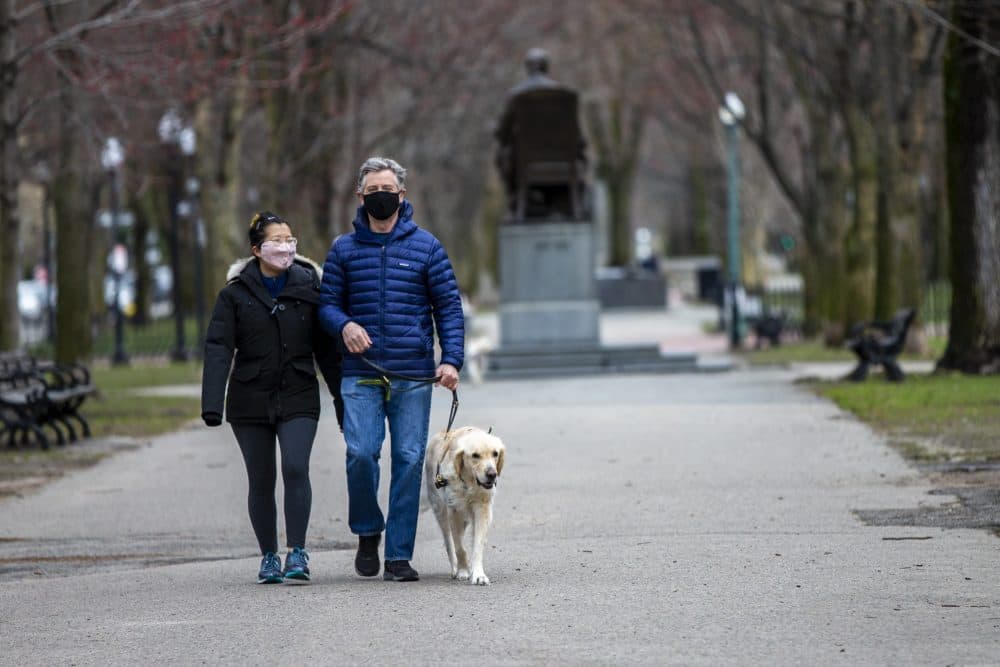Advertisement
How To Seek A Safe Respite Outdoors While Social Distancing

You're cooped up. You're feeling cut off from human contact. And it seems the only way to seek refuge these days is to head outdoors for a walk, jog, or some quality time on a park bench.
But if your great escape to nature is interrupted by someone coughing as they pass by, you may be left wondering if you can be completely carefree outside.
WBUR's All Things Considered host Lisa Mullins spoke with Dr. Richard Serrao, an infectious disease physician with the VA Boston Healthcare System and clinical associate professor at the Boston University School of Medicine, about whether the outdoors can still be a respite for us.
Serrao says it's fine to spend time outside, but keep your distance from others, because scientists don't know yet how transmissible the coronavirus is in open air.
Interview Transcript
If you're running with a friend, if you're running side by side, close together, you're running against the wind. And the probability [is], given your speed, that if you were to talk or cough or sneeze, that those droplets — provided that they're directed away from the person next to you — will fall behind you. But the one thing to keep in mind is that, if you're in New York in Central Park, or in a busy part of Boston — which it isn't [busy] now — you have to be mindful of who you're coughing or sneezing [near] that may be down stream ... or downwind from you.
So if if you happen to be walking behind the pack of joggers and one of them coughs, what happens?
Well, again, we want to be as mindful of maintaining our sanity and social distancing. But the best thing to do is to keep our distance from each other as much as we can in all environments. Again, the probability is more than likely lower when you're out in the open air. But again, if you are downstream from a runner ahead of you or a jogger ahead of you by a couple of feet ... if they sneeze or cough, those droplets will be aerosolized as if they sprayed a mister into the air. And if you run into them, you could certainly get that ... But I think as you're jogging, the probability of these aerosols hanging in the air in the open environment is less than in a stagnant air, closed space environment. But it could still theoretically get into our eyes or our nose or our mouth if we run into those aerosols.
So what's the bottom line on that, then? If I am behind not just joggers, but somebody who's walking, what is really a safe distance just in case they let loose with a sneeze?
The ideal thing is six feet. But keep in mind, the six feet refers to when we are relatively sitting still. The piece of the equation here is that if you are walking into an airspace that a person ahead of you just sneezed into, that six feet may become one foot as you walk into that air. So the the short answer is it's best that if you're walking behind somebody, walk a little bit more to the sides, rather than directly downstream from from someone.
What if you need a break when you're jogging or walking, and you want to sit on the bench and nobody else is there? Can you catch anything from the bench?
No, the probably of that is low ... It really depends on the ability of any bacteria, or virus in this case, of sticking onto that surface — and then as you're seated, and your hands touch that surface, and then your hands touch your eyes and your nose and your mouth. But in the outside environment, with weather and wind and rain and water, the probability of these viruses adhering to park bench — even though it hasn't been studied — is probably less than what we're reading about how these viruses stick onto plastic or metal.
What about kids who are on a jungle gym? I mean, that's generally made of metal or plastic.
The pieces of info that are useful [to know about the safety of] the outdoor gym is the proximity of the kids with each other and ... what can be transmitted through touch. If you have 20 kids that are congregated on one jungle gym and one of the kids has this [virus], it's quite easily that all the kids could very well come in contact with that ... So that would be an instance in which parents can keep a close eye on their kids ... move about as much [as possible], rather than being stagnant ... for prolonged periods of time.
Understanding that for our mental health, we may want to go out and see a nice garden or walk a trail, or see the Boston [Public] Garden crocuses blooming. You're saying that's good, but just keep moving?
Yeah, that's good. But just keep moving ... So if it's a balance between one's sanity and ability to not get cabin fever during this time, and an individual would like to go out and about, yes, being out and about is going to be, for the most part, less of a dense situation than being in an office full of 100 people.
This segment aired on March 25, 2020.

